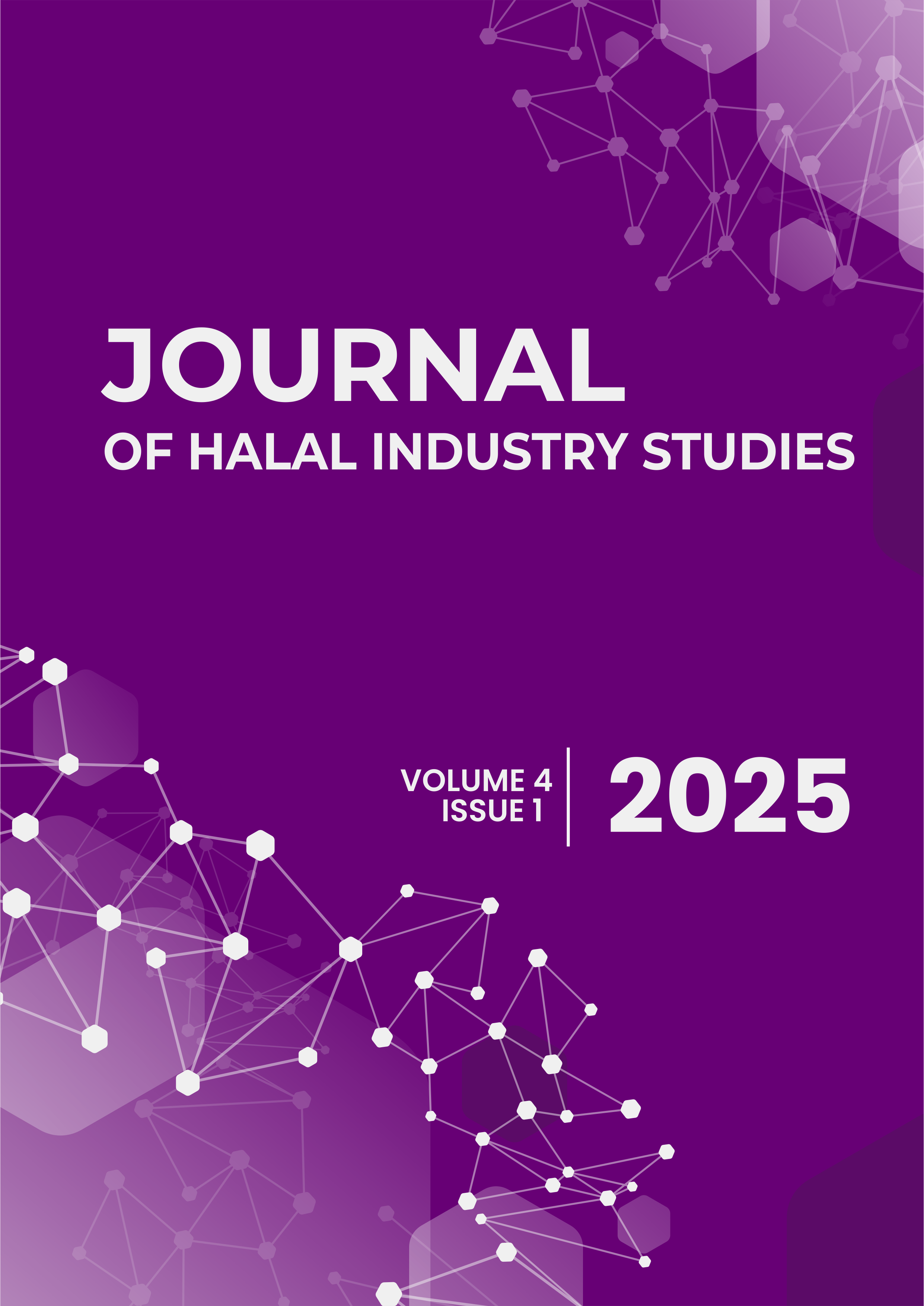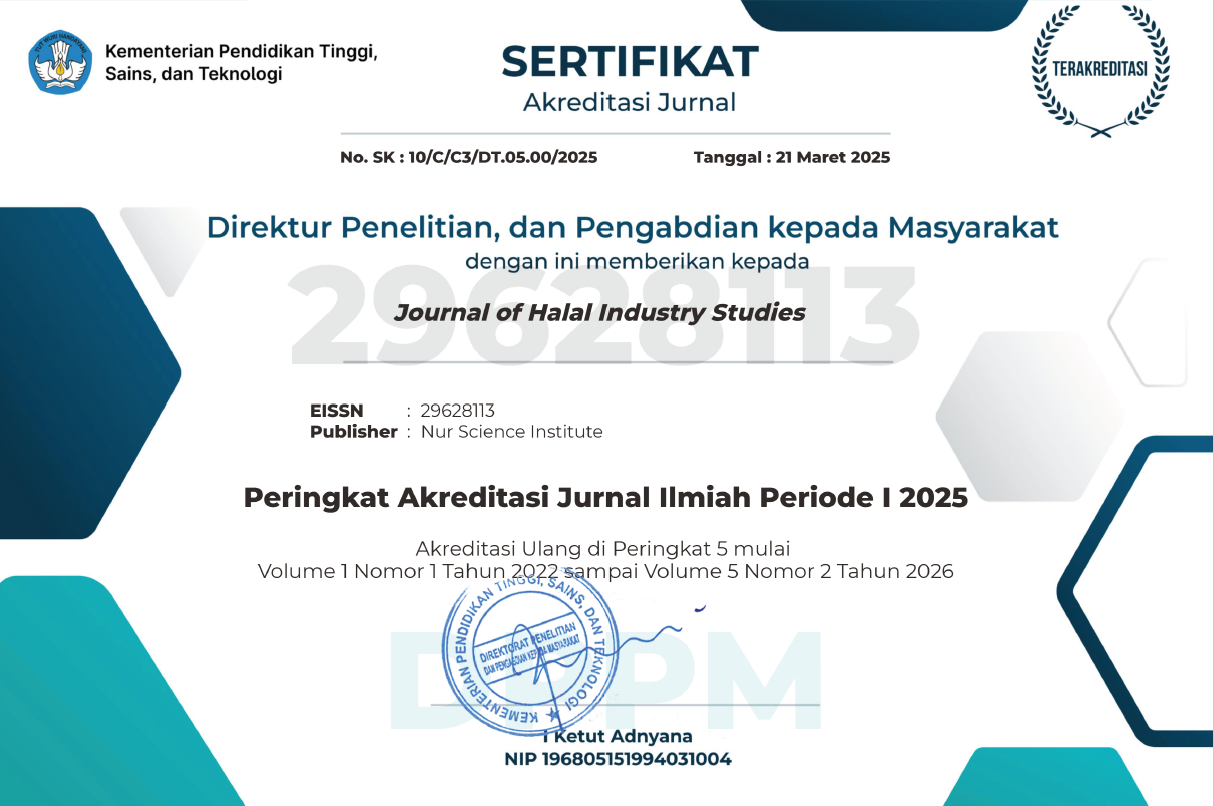Rancang bangun model rantai pasok halal Ayam Joper: Integrasi HAS 23000, SNI 99002:2016, dan Model SCOR
DOI:
https://doi.org/10.53088/jhis.v4i1.1771Keywords:
Halal Supply Chain, HAS 23000, SNI 99002:2016, SCORAbstract
This study aims to design a halal supply chain model for Joper chicken by integrating the Halal Assurance System (HAS 23000), the Indonesian National Standard for halal poultry slaughtering (SNI 99002:2016), and the Supply Chain Operations Reference (SCOR) model. The research identifies ten Halal Critical Points (HCPs) along the supply chain from upstream to downstream. Through direct observation, interviews with stakeholders (farmers, brokers, poultry slaughterhouse operators, and restaurant owners), and literature review, this study identifies potential risks that could threaten halal status. A total of 31 risk events were mapped using the guidelines from SNI 99002:2016. The SCOR model was then applied to systematically structure the halal supply chain framework based on five pillars: Plan, Source, Make, Deliver, and Return. The result is a comprehensive and integrated halal supply chain model that enhances traceability, control, and assurance of halal integrity in the Joper chicken business processes. The proposed halal supply chain model enhances traceability, halal quality control, and risk management across all stages. This model serves as a valuable reference for industry practitioners and policymakers to strengthen halal assurance systems in Indonesia's poultry sector.
References
Abd Rahman, A., Singhry, H. B., Hanafiah, M. H., & Abdul, M. (2017). Influence of perceived benefits and traceability system on the readiness for Halal Assurance System implementation among food manufacturers. Food Control, 73, 1318–1326. https://doi.org/10.1016/j.foodcont.2016.10.058
Ali, M. H., & Suleiman, N. (2018). Eleven shades of food integrity: A halal supply chain perspective. Trends in Food Science and Technology, 71(April 2017), 216–224. https://doi.org/10.1016/j.tifs.2017.11.016
Ariffin, M. F., Syahadah, N., Riza, M., Hamid, F. A., Awae, F., & Nasir, B. M. (2021). Halal Food Crime in Malaysia: An Analysis On Illegal Meat Cartel Issues. Journal of Contemporary Issues in Business and Government, 27(02), 0–5. https://doi.org/10.47750/cibg.2021.27.02.152
Faridah, A., Syarif, W., & Holinesti, R. (2019). Identification of Halal Critical Points of Fried. Second International Conference on Cullinary, Fashion, Beauty, and Tourism (ICCFBT) 2019, 2012, 9–20.
Fuseini, A., Wotton, S. B., Knowles, T. G., & Hadley, P. J. (2017). Halal Meat Fraud and Safety Issues in the UK: a Review in the Context of the European Union. Food Ethics, 1(2), 127–142. https://doi.org/10.1007/s41055-017-0009-1
Jaapar, N., Abdul Razak, U. H., Abdul Halim, A. H., & Basri, F. (2021). Factors Contributing to Halal Food Fraud in Selangor. Environment-Behaviour Proceedings Journal, 6(SI6), 39–44. https://doi.org/10.21834/ebpj.v6isi6.3118
Maman, U., Mahbubi, A., & Jie, F. (2017). Strategic Planning to Control Halal Risk in Indonesian Beef Supply Chain. International Business Management, 11(6), 1246–1253.
Nazri, M., Rahman, A., & Md.Shaarani, S. (2012). Study on the Effectiveness of Halal Certification in Slaughtering House Around Kota Kinabalu , Sabah. International Conference on Food Science and Nutrition, April, 895–918.
Peristiwo, H. (2020). Indonesian Food Industry on Halal Supply Chains. Food ScienTech Journal, 1(2), 69. https://doi.org/10.33512/fsj.v1i2.6475
Ramli, M. H., Rosman, A. S., Sikin, A. M., Jamaludin, M. A., & Ajmain, M. T. (2020). Halal Assurance at Farm Level in the Poultry Supply Chain. Journal of Islamic, Social, Economics and Development (JISED), 5(31), 1–11.
Razaly, M. M., Zakaria, Z., Ismail, S. Z., & Jusoh, A. (2018). The Determination of Halal Critical Point in Halal Certified Chicken Slaughterhouses and Its Significance. Proceedings of the 3rd International Halal Conference (INHAC 2016), Inhac 2016, 259–271. https://doi.org/10.1007/978-981-10-7257-4_24
Ruslan, A. A. A., Kamarulzaman, N. H., & Sanny, M. (2018). Muslim consumers’ awareness and perception of Halal food fraud. International Food Research Journal, 25(December), S87–S96.
Shahdan, D., Ahmad, S. H., Chen, R. S., Ali, A. M., & Zailan, F. D. (2016). Optimization of processing parameter for fabrication of polylactic acid/liquid natural rubber/graphene nanoplatelet by tensile properties. AIP Conference Proceedings, 1784. https://doi.org/10.1063/1.4966803
Soon, J. M., Chandia, M., & Regenstein, J. Mac. (2017). Halal integrity in the food supply chain. British Food Journal, 119(1), 39–51. https://doi.org/10.1108/BFJ-04-2016-0150
Wahyuni, D., Nasution, A. H., Budiman, I., & Arfidhila, N. (2020). Halal Risk Analysis at Indonesia Slaughterhouses Using the Supply Chain Operations Reference (SCOR) and House of Risk (HOR) Methods. Journal of Physics: Conference Series, 1542(1). https://doi.org/10.1088/1742-6596/1542/1/012001
Downloads
Published
How to Cite
Issue
Section
License
Copyright (c) 2025 Muhammad Fitri Budi Utomo, Siti Dinar Rezki Ramadhani

This work is licensed under a Creative Commons Attribution-ShareAlike 4.0 International License.
Authors who publish with this journal agree to the following terms:
The author(s) retain copyright and grant the journal the right of first publication with the work simultaneously licensed under a CC BY-SA 4.0 license that allows others to remix, adapt, and build upon the work even for commercial purposes, as long as they credit the author(s) and license their new creations under the identical terms.
License details: https://creativecommons.org/licenses/by-sa/4.0/


